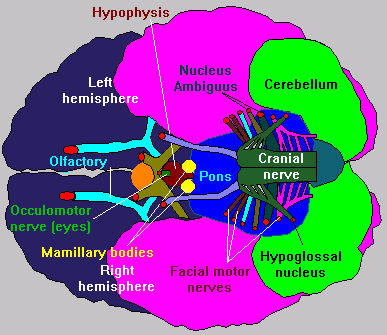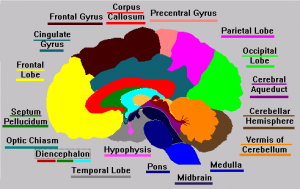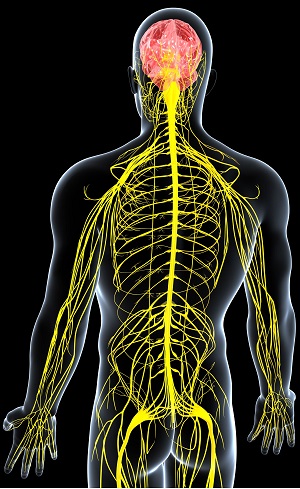28 Aug Sensory Input to the Brain
Part of the definition of any computer program is defining the inputs and outputs, where they come from, what they are and where they get processed. Fortunately, we know enough about the brain to answer many of these questions, thus we have a basis for defining artificial models that, in some way, mimic these elements of brain activity.
Input Channels
 The sensory system axons are connected to nuclei in the thalamus which, in turn, project their axons into subcortical structures such as the basal ganglia and hypothalamus to transmit impulses. Other neurons in the thalamus act as cortical relays. They receive fibers from the sensory tracts, cerebellum, reticular system, and basal ganglia. These neurons project their axons into the cerebral cortex. Association neurons have input links only with other diencephalar cells, but they project their output fibers to the association areas of the cerebrum.
The sensory system axons are connected to nuclei in the thalamus which, in turn, project their axons into subcortical structures such as the basal ganglia and hypothalamus to transmit impulses. Other neurons in the thalamus act as cortical relays. They receive fibers from the sensory tracts, cerebellum, reticular system, and basal ganglia. These neurons project their axons into the cerebral cortex. Association neurons have input links only with other diencephalar cells, but they project their output fibers to the association areas of the cerebrum.
| Understanding Context Cross-Reference |
|---|
| Click on these Links to other posts and glossary/bibliography references |
|
|
|
| Prior Post | Next Post |
| Brain Correlation Processes | Black Boxes – Specialized Brain Areas |
| Definitions | References |
| sensory inputs outputs | Brain Balance Pansky 1988 |
| thalamus hypothalamus | Thalamus in Brain Development |
Sensory impulses result from some outside stimulation or input, such as incoming light from the retina. In the eye, photosensitive cells react to light intensity and color to begin electrochemical chain-reactions in the brain (I’ll cover those chemical reactions in future posts). These inputs can trigger responses such as looking at something interesting in the field of view. This means that incoming stimuli, besides being interpreted, may be acted upon immediately.
The Cranial Nerve
 This is a bottom view of the human brain showing the nerves that control facial expression. It also shows the sources of motor control of the eyes, mouth, and all muscles north of the neck. The conspicuous conduits for nerve fibers strengthen the electric circuit metaphor and reinforce the idea that form is integral to function in the human brain. The observable rapidity with which a person can refocus their eyes based on something they see implies a tight interconnectedness between perception and behavior or action.
This is a bottom view of the human brain showing the nerves that control facial expression. It also shows the sources of motor control of the eyes, mouth, and all muscles north of the neck. The conspicuous conduits for nerve fibers strengthen the electric circuit metaphor and reinforce the idea that form is integral to function in the human brain. The observable rapidity with which a person can refocus their eyes based on something they see implies a tight interconnectedness between perception and behavior or action.
 The reticular activating system (RAS) is part of the visual system that occupies several localized areas of the brain. The RAS is a network of neurons that extends from the brainstem to the cortex (primarily medulla, pons, midbrain – bottom right in illustration). This network of neurons filters incoming sensory stimuli, allowing attention to focus on critical inputs and ignore noise. Specific neuron groups forming the RAS include the midline, intralaminar and reticular thalamis nuclei [Pansky, et al., 1988, p. 260].
The reticular activating system (RAS) is part of the visual system that occupies several localized areas of the brain. The RAS is a network of neurons that extends from the brainstem to the cortex (primarily medulla, pons, midbrain – bottom right in illustration). This network of neurons filters incoming sensory stimuli, allowing attention to focus on critical inputs and ignore noise. Specific neuron groups forming the RAS include the midline, intralaminar and reticular thalamis nuclei [Pansky, et al., 1988, p. 260].
Sensory processing doesn’t always work perfectly. “While all children can seem quirky or particular about their likes and dislikes, children with Sensory Processing Disorder (also called Sensory Integration Dysfunction) will be so severely affected by their sensory preferences that it interferes with their normal, everyday functioning. Sensory issues are usually defined as either hypersensitivity (over-responsiveness) or hyposensitivity (under-responsiveness) to sensory stimuli” (Brain Balance). Also, see my post on Learning from Brain Disorders.
Hypersensitivities to sensory input may be characterized by unusual or extreme behaviors such as:
- heightened response or fear of sudden, loud, or high-pitched noises that seem unoffensive to others
- Sensitivity to or distraction due to background noises that others filter out
- Fear of unexpected physical contact, or avoids embracing or snuggling, even with familiar adults
- Exhibits fear of crowds or avoids standing too close to other people
- Avoids games involving physical contact with people or even some types of playground equipment
- Excessive fear of climbing or falling, even in the absence of real danger (i.e. doesn’t like his or her feet to be off the ground)
- May sometimes have poor balance, or fall more often than normal
Hyposensitivities to sensory input may be characterized by:
 Frequent need to touch people or textures, even at inappropriate times
Frequent need to touch people or textures, even at inappropriate times- Inability to understand personal space even after the age when most people intuitively grasp the concept
- Clumsy and/or poorly coordinated body movements
- Unusually high tolerance for, or indifference to pain
- Frequently harms other children and/or pets when playing ( i.e. doesn’t understand one’s own strength)
- Exhibits fidgeting or inability to sit still
- Gravitates to activities with constant movement, like spinning, jumping
- Appears more intent on seeking thrills, even risking dangerous at times
Computers, too, may over or under utilize input in processing information and making decisions. This has been an important area of research and experimentation in designing and tweaking autonomous vehicles, especially driverless automobiles that need to be able to operate effectively in environments of much more input than is strictly relevant to the task of safely navigating roads.
The key points I want to emphasize in this post is that the brain has many tightly interconnected specialized areas that have different responsibilities like any complex machine. Like computers, the brain has specialized input and output mechanisms that cooperate with other functional areas. Consequently, the model that successfully mimics some of these functions can have different parts that, at many levels, look identical, while from a process and organization perspective they are radically different. This understanding implies that even if computer hardware or software mimics the massively parallel structure of the brain, the processes must vary significantly to support input, correlation and more advanced cognitive tasks.
| Click below to look in each Understanding Context section |
|---|








